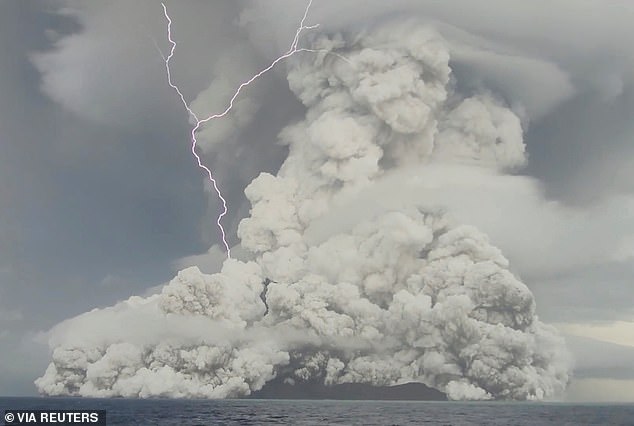Scientists have identified a mysterious signal that occurred just minutes before the most powerful explosion in modern times — the eruption of a volcano in the Pacific.
When the underwater Hunga Tonga-Hunga Ha’apai volcano exploded in 2022, it let out the energetic equivalent of 61 megatons of TNT, or a magnitude 8.4 earthquake.
A team with Japan‘s Earthquake Research Institute discovered a ‘seismic wave’ created ahead of that blast, which was released when a weak part of the ocean floor collapsed near the volcano.
This sent vibrations traveling through the seafloor, which were picked up by distant monitoring stations 15 minutes before the eruption.
The study explained that this crack in the Tonga volcano’s walls allowed seawater and magma to mix in an area between the seafloor and its underground magma chamber, ultimately triggering the massive ‘steam’ eruption.
‘Many eruptions are preceded by seismic activity,’ said Takuro Horiuchi, a student volcanologist at the University of Tokyo, who served as the study’s lead author.
But Horiuchi noted that more often than not ‘such seismic signals are subtle and only detected within several kilometers of the volcano.’
The team hopes lessons learned from their work can one day help deploy ‘this kind of analysis in real-time’ for emergency responders ahead of future volcanic activity.

When Hunga Tonga-Hunga Ha’apai blew in the South Pacific on January 15, 2022, scientists marveled that the sound waves from its historic submerged detonation could be detected as far off as Alaska, 6,200 miles away.
Roughly 58,000 Olympic swimming pools of water vapor were launched into the air, generating lightning storms and a tsunami in the Tonga volcano’s aquatic wake.
At the time, researchers noted that comparisons to the famed 1883 explosion of Indonesia’s Krakatoa volcano put the Tonga blast in the running for the largest explosion ever recorded by modern geophysical equipment.
Knowing seismic activity proceeds volcanic eruptions, the team looked at data from two earthquake-monitoring stations on the islands of Fiji and Futuna over 466 miles away.
They found indications of Rayleigh waves, a vibration only detected by instruments.
Tonga erupted at 4:47pm local time and the waves were created at 4:32pm, exactly 15 minutes before.
Despite that vast distance, the Rayleigh waves ‘dominated’ in 0.03–0.1 hertz (Hz) frequency range, they wrote, giving off readings (in amplitude) comparable to a 4.9 magnitude earthquake.

But the earthquake-like rattling caused by the volcano’s eruption itself was even more powerful.
‘The arrival time difference of the Rayleigh wave between the two stations was consistent with that of the M5.8 earthquake during the eruption,’ the team wrote in their study, published this month in Geophysical Research Letters, an open-access journal of American Geophysical Union.
Another key set of information that helped inform their predictive model for this undersea volcano’s explosive event came from satellite gravity data.
The data was collected via satellites that continually measured their distance from one another, using microwave ranging instruments, as a gauge of Earth’s gravitational pull on their mass.
The Tonga event, they argued, maybe what is known as a ‘caldera-forming eruption,’ in which so much magma is emptied that areas above the magma reservoir collapse.

‘There are very few observed caldera-forming eruptions, and there are even fewer witnessed caldera-forming eruptions in the ocean,’ according to Dr Mie Ichihara, a volcanologist at the University of Tokyo and a co-author on the new study.
‘This gives one scenario about the processes leading to caldera formation,’ Dr Ichihara noted in a press statement, ‘but I wouldn’t say that this is the only scenario.’
‘Penetration of magma, magmatic gas, and seawater’ into a fracture in Earth’s crust along the Tonga volcano’s ‘caldera’ wall, they reported in their new study, might have led to a steam pressure event, a ‘magma-water interaction triggering the eruption.’
A previous study on the Tonga volcano’s ‘plumbing’ had used this gravity data to determine ‘a circular distribution of low-density material,’ surrounding the volcano, which they interpreted as ‘ring fracturing’ around the caldera walls, the team wrote.
Dr Ichihara expressed the hope that all of these disparate sensors might one day be used to make potentially fatal activity of undersea volcanoes easier to anticipate and respond to safely.
‘Early warnings are very important for disaster mitigation,’ he said. ‘Island volcanoes can generate tsunamis, which are a significant hazard.’

